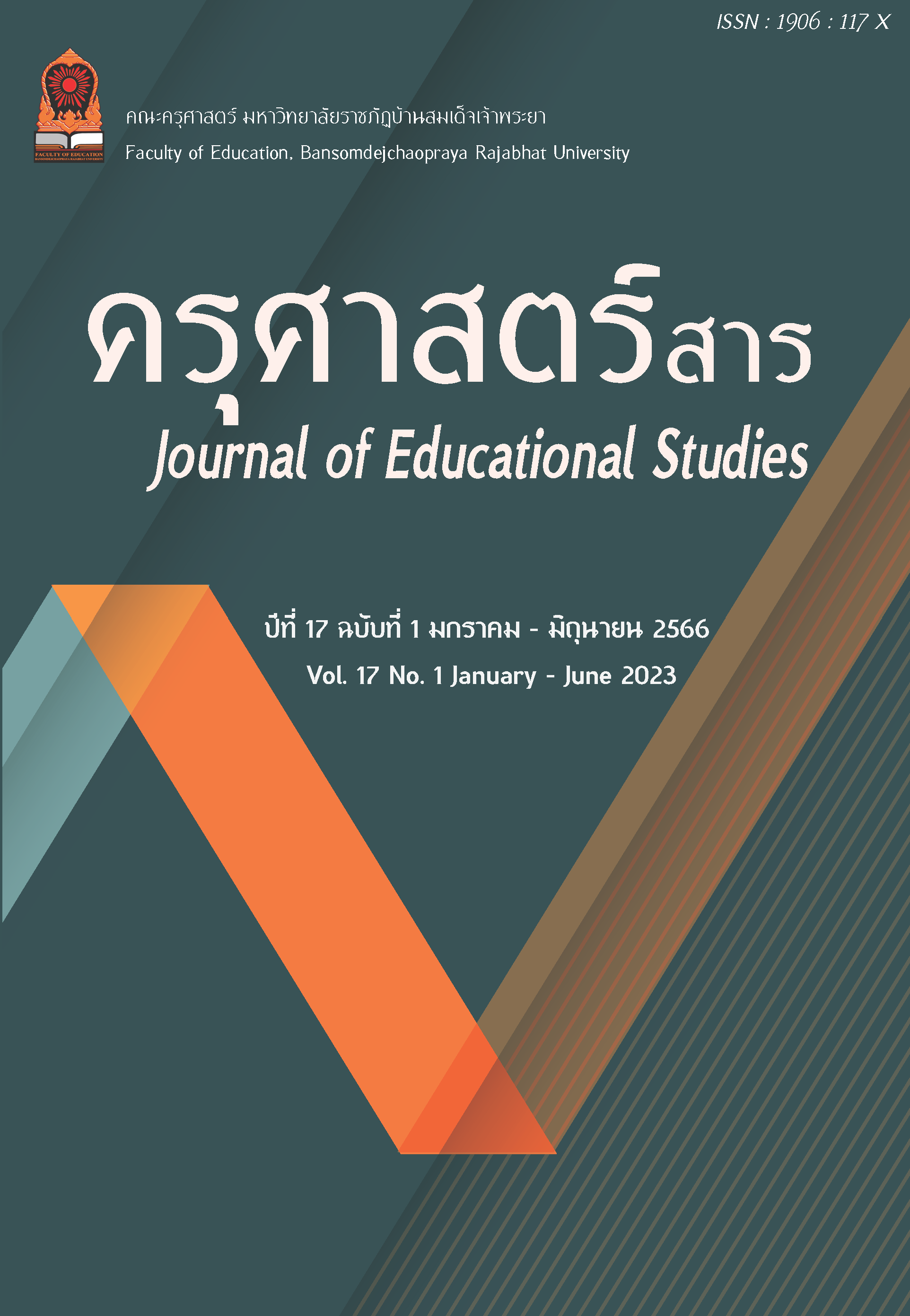Components and Quality Indicators for Assessment and Judging of Thai Music Ensemble Competition
Keywords:
Components and Quality Indicators, Assessment and Judging, Thai Music Ensemble CompetitionAbstract
The objective of this research is to develop components and quality indicators's
assessment and judging of Thai music ensemble competition with a mixed method ofresearch methodology with qualitative research that applied to the Delphi technique'sresearch method and experimental research.The research results showed that components and quality indicators's assessmentand judging of Thai music ensemble competition that consist; (1) elements of music skills
which contains quality indicators are the musician's personality and melody, (2) elementsof vocal skills which contains quality indicators are the singer's personality and lyric,(3) elements of ensemble skills which contains quality indicators are tempo and ensembleadjustment tactics. Quality inspection results of components and quality indicators'sassessment and judging of Thai music ensemble competition found that measurementand evaluation tools according to the components and quality indicators's assessmentand judging of Thai music ensemble competition by made into score record formaccording to the components and quality indicators's assessment and judging of Thaimusic ensemble competition that construct validity analysis results with the average ofscores from the evaluation results according to the components and quality indicators'sassessment and judging of Thai music ensemble competition between Thai ensemblegroups that have highly skilled (through to the finals round) ( X = 8 7 . 1 0 , S.D. = 3 . 9 1 )higher more than Thai ensemble groups that have low to moderate skilled level (qualified
for the qualifying round but did not qualify for the finals round) ( X =80.88, S.D. = 1.72)which statistical significance of . 0 5 level. There is Rater Agreement Index (Judges of theThai music ensemble competition, the royal cup of Her Royal Highness Princess MahaChakri Sirindhorn, Year 2023) is 0.864 – 0.964 in high level has reliability of measurement and evaluation tools equals .965 shows that the tool is reliable and can actually use this tool. In addition, the analysis results of the content consistency index were consistent across all assessment items and is appropriate at the highest level.
Downloads
References
กมลวรรณ ตังธนกานนท์. (2557). การวัดและการประเมินทักษะการปฏิบัติ. พิมพ์ครั้งที่ 1.กรุงเทพมหานคร: สำนักพิมพ์แห่งจุฬาลงกรณ์มหาวิทยาลัย.
จันทนา คชประเสริฐ. (2545). เอกสารประกอบการสอนวิชาประวัติดนตรีไทย รหัส 626253. ชลบุรี : คณะศิลปกรรมศาสตร์ มหาวิทยาลัยบูรพา.
จันทนา คชประเสริฐ และกิตติภัณฑ์ ชิตเทพ. (2559). หลักเกณฑ์การตัดสินและการประเมินผลการบรรเลงในการประกวดดนตรีไทย. งานวิจัย คณะดนตรีและการแสดง มหาวิทยาลัยบูรพา.
จันทนา คชประเสริฐ และกิตติภัณฑ์ ชิตเทพ. (2559). หลักเกณฑ์การตัดสินและการประเมินผลการบรรเลงในการประกวดดนตรีไทย. ครุศาสตร์สาร. 12(2), 51 – 72.
โชติกา ภาษีผล. (2558). การสร้างและพัฒนาเครื่องมือในการวัดและประเมินผลทางการศึกษา. พิมพ์ครั้งที่ 2. กรุงเทพมหานคร : สำนักพิมพ์แห่งจุฬาลงกรณ์มหาวิทยาลัย.
โชติกา ภาษีผล, ณัฏญภรณ์ หลาวทอง และ กมลวรรณ ตังธนกานนท์. (2554). การวัดและประเมินผลการเรียนรู้. กรุงเทพมหานคร : สำนักพิมพ์แห่งจุฬาลงกรณ์มหาวิทยาลัย.
ณรุทธ์ สุทธจิตต์. (2560). วิธีวิทยาการสอนดนตรี. พิมพ์ครั้งที่ 2. กรุงเทพมหานคร: พรรณีพริ้นติ้งเซ็นเตอร์.
ณวัฒน์ หลาวทอง. (2555). การศึกษาและพัฒนาเกณฑ์มาตรฐานการตัดสินการประกวดการบรรเลงวงดนตรีไทย. วิทยานิพนธ์ปรัชญาดุษฎีบัณฑิต(วัฒนธรรมศาสตร์) มหาวิทยาลัยมหาสารคาม.
ประยุทธ ไทยธานี. (2546). การสร้างและพัฒนาแบบสอบความถนัดทางดนตรีไทย. วิทยานิพนธ์ครุศาสตรดุษฎีบัณฑิต(จิตวิทยา) จุฬาลงกรณ์มหาวิทยาลัย.
พิชิต ฤทธิ์จรูญ. (2559). การประเมินเพื่อพัฒนาผู้เรียน. วารสารศึกษาศาสตร์ มสธ. 9(1), 1-17.
เพชราวดี จงประดับเกียรติ. (2560). การพัฒนาเครื่องมือวัดทักษะพิสัย. เอกสารประกอบการเรียนรายวิชาการพัฒนาเครื่องมือวัดทักษะพิสัย. กรุงเทพมหานคร: คณะครุศาสตร์ มหาวิทยาลัยราชภัฏบ้านสมเด็จเจ้าพระยา.
มนตรี ตราโมท และวิเชียร กุลตัณฑ์. (2523). ฟังและเข้าใจเพลงไทย. กรุงเทพฯ : โรงพิมพ์ไทยเขษม.
ยุทธนา ฉัพพรรณรัตน์ วิชฏาลัมพก์ เหล่าวานิช และสิวะโชติ ศรีสุทธิยากร. (2561). การพัฒนาเครื่องมือประเมินและระบบคุณภาพการตัดสินผลการประกวดบรรเลงรวมวงมโหรี. วารสารครุศาสตร์ จุฬาลงกรณ์มหาวิทยาลัย. 46(4), 300 - 317.
สุพัตรา วิไลลักษณ์. (2556). การจัดการศึกษาดนตรีไทยในอนาคต. วิทยานิพนธ์ปรัชญาดุษฎีบัณฑิต (ดุริยางคศิลป์) มหาวิทยาลัยมหาสารคาม.
สำนักมาตรฐานอุดมศึกษา สำนักงานปลัดทบวงมหาวิทยาลัย. (2544). เกณฑ์มาตรฐานดนตรีไทยและเกณฑ์การประเมิน. กรุงเทพฯ : ภาพพิมพ์.
สำนักมาตรฐานและประเมินผลอุดมศึกษา สำนักงานคณะกรรมการการอุดมศึกษา. (2553). เกณฑ์มาตรฐานดนตรีไทย พุทธศักราช 2553. พิมพ์ครั้งที่ 2. กรุงเทพฯ : ภาพพิมพ์.
Wesdoski, Brian C.. (2012). Understanding and Developing Rubrics for Music Performance Assessment. Music Educators Journal. 98(3), 36-42.
Macmillan, Thomas T. (1971). The Delphi Technique. The Annual Meeting of the California Junior Colleges Associations Committee on Research and Development. Ca : Monterey, May 3-5.
Scott, S. J. (2012). Rethinking the roles of Assessment in Music Education. The National Association for Music Education. 98
Downloads
Published
How to Cite
Issue
Section
License

This work is licensed under a Creative Commons Attribution-NonCommercial-NoDerivatives 4.0 International License.
บทความที่ได้รับการตีพิมพ์เป็นลิขสิทธิ์ของคณะครุศาสตร์ มหาวิทยาลัยราชภัฏบ้านสมเด็จเจ้าพระยา
ข้อความที่ปรากฏในบทความแต่ละเรื่องในวารสารวิชาการเล่มนี้เป็นความคิดเห็นส่วนตัวของผู้เขียนแต่ละท่านไม่เกี่ยวข้องกับมหาวิทยาลัยราชภัฏบ้านสมเด็จเจ้าพระยา และคณาจารย์ท่านอื่นๆในมหาวิทยาลัยฯ แต่อย่างใด ความรับผิดชอบองค์ประกอบทั้งหมดของบทความแต่ละเรื่องเป็นของผู้เขียนแต่ละท่าน หากมีความผิดพลาดใดๆ ผู้เขียนแต่ละท่านจะรับผิดชอบบทความของตนเอง



